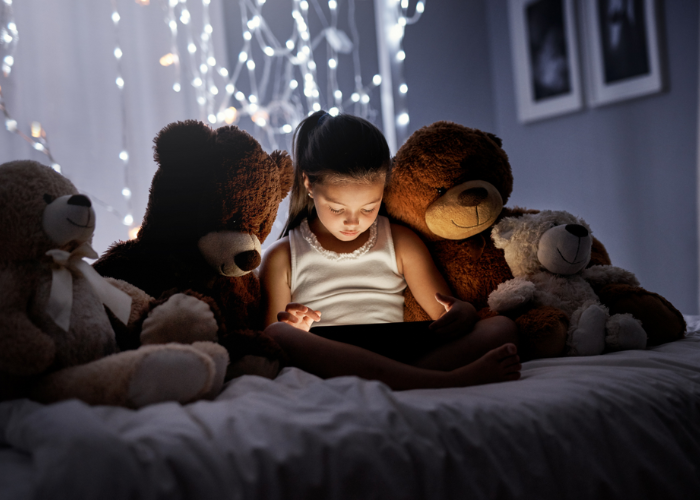The effects of blue light on your child’s health and sleep
Our children’s generation are growing up with screens as part of their every day life. The effects of blue light on your child’s health and sleep can be really significant so it makes sense to take steps to reduce the impact.
What is blue light and why is it a problem?
Blue light is also known as high-energy visible (HEV) light. The largest source of blue light is the sun but we don’t get a break from it because it’s also present with indoor screen usage and fluorescent and LED lights.
Blue light is a short wavelength and one which our eye’s cornea and lens are unable to block or reflect. It passes through the eye to the retina and can cause eye damage.
So while some amount of blue light is good for us (helping regulate our circadian system, making us alert and boosting cognition), prolonged exposure to artificial sources is not.
Children are more at risk from blue light exposure
In 2017, the Australian Child Health Poll found that children aged six to twelve averaged 32 hours per week in front of a screen, two to five-year-olds had 26 hours of weekly screen time, and infants and toddlers averaged 14 hours.
Staggering statistics, right?
Add to that the presence of blue light in the home and school through lighting, our kids are being exposed to an excessive amount.
Because children’s brains and nervous systems are still growing and developing, they are more sensitive to blue light. This sensitivity can show up in health, behavioural and developmental issues.
Sleep Disturbances
Excessive blue light exposure suppresses melatonin production and interferes with children’s natural circadian rhythms (the natural body clock). This seems to affect children twice as much as adults! Getting kids into a healthy sleeping pattern where they are able to restore and replenish, is compromised when there is too much blue light exposure.
Disturbing the body’s circadian rhythm and natural sleep patterns while over stimulating the brain with blue light can have a knock-on effect with changes in behaviour, mental health and learning difficulties.
Eye Health Issues
Blue light exposure may lead to problems with eye health including eye strain and blurry vision as well as headaches and trouble focusing. Remember how blue light can penetrate right into the retina?
It has also been linked to an increase in near-sightedness amongst children.
How to reduce your child’s blue light exposure
Remove screen devices from the bedroom at night
Remove anything with LED lighting (like night lights)
Switch lightbulbs to smaller wattage and preferably amber, red or low blue light versions
Use block out curtains and avoid turning on lights when waking
Wear blue light blocking glasses (especially at night time)
Install apps on devices to reduce blue light (Nightshift, Twilight, Flux)
Reduce screen time (at least two hours screen free before bed)
Lead by example and create a culture in your home and family of limited screen time
The effect of blue light on your child’s health and sleep is a really concerning issue. Try to prioritise natural blue light and outdoor time as much as possible and limit artificial blue light. A child who is in synch with their circadian rhythms is infinitely happier and healthier.
If your child has a lot of screen time, try these changes and see how you go! It may take some time to notice the effects, but either way, it’s not going to be a bad thing.
Get 10% off Blue Light Blocking Products with the code: DRCARRIE here.
Get 15% off Blue Light Blocking Products with the code: CARRIE15 here.
I use products from both these companies and can highly recommend them.
Want to learn more about how to optimise your child’s health naturally? Check out the Regulated and Thriving Kids Membership.
PS. This post contains affiliate links. When you purchase from these links, there is no additional cost to you but I receive a small commission that honours the time I spend researching amazing products. Thank you for your support.




